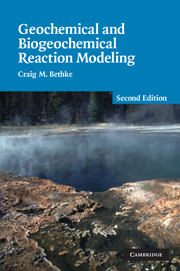Book contents
- Frontmatter
- Contents
- Preface
- Preface to first edition
- A note about software
- 1 Introduction
- 2 Modeling overview
- Part I Equilibrium in natural waters
- Part II Reaction processes
- Part III Applied reaction modeling
- 22 Hydrothermal fluids
- 23 Geothermometry
- 24 Evaporation
- 25 Sediment diagenesis
- 26 Kinetics of water–rock interaction
- 27 Weathering
- 28 Oxidation and reduction
- 29 Waste injection wells
- 30 Petroleum reservoirs
- 31 Acid drainage
- 32 Contamination and remediation
- 33 Microbial communities
- Appendix 1 Sources of modeling software
- Appendix 2 Evaluating the HMW activity model
- Appendix 3 Minerals in the LLNL database
- Appendix 4 Nonlinear rate laws
- References
- Index
22 - Hydrothermal fluids
Published online by Cambridge University Press: 05 August 2012
- Frontmatter
- Contents
- Preface
- Preface to first edition
- A note about software
- 1 Introduction
- 2 Modeling overview
- Part I Equilibrium in natural waters
- Part II Reaction processes
- Part III Applied reaction modeling
- 22 Hydrothermal fluids
- 23 Geothermometry
- 24 Evaporation
- 25 Sediment diagenesis
- 26 Kinetics of water–rock interaction
- 27 Weathering
- 28 Oxidation and reduction
- 29 Waste injection wells
- 30 Petroleum reservoirs
- 31 Acid drainage
- 32 Contamination and remediation
- 33 Microbial communities
- Appendix 1 Sources of modeling software
- Appendix 2 Evaluating the HMW activity model
- Appendix 3 Minerals in the LLNL database
- Appendix 4 Nonlinear rate laws
- References
- Index
Summary
Hydrothermal fluids, hot groundwaters that circulate within the Earth's crust, play central roles in many geological processes, including the genesis of a broad variety of ore deposits, the chemical alteration of rocks and sediments, and the origin of hot springs and geothermal fields. Many studies have been devoted to modeling how hydrothermal fluids react chemically as they encounter wall rocks, cool, boil, and mix with other fluids. Such modeling proliferated in part because hydrothermal fluids are highly reactive and because the reaction products are commonly well preserved, readily studied, and likely to be of economic interest. Further impetus was provided by the development of reliable modeling software in the 1970s, a period of concern over the availability of strategic and critical minerals and of heightened interest in economic geology and the exploitation of geothermal energy.
As a result, many of the earliest and most imaginative applications of geochemical modeling, beginning with Helgeson's (1970) simulation of ore deposition in hydrothermal veins and the alteration of nearby country rock, have addressed the reaction of hydrothermal fluids. For example, Reed (1977) considered the origin of a precious metal district; Garven and Freeze (1984), Sverjensky (1984, 1987), and Anderson and Garven (1987) studied the role of sedimentary brines in forming Mississippi Valley-type and other ore deposits; Wolery (1978), Janecky and Seyfried (1984), Bowers et al. (1985), and Janecky and Shanks (1988) simulated hydrothermal interactions along the midocean ridges; and Drummond and Ohmoto (1985) and Spycher and Reed (1988) modeled how fluid boiling is related to ore deposition.
- Type
- Chapter
- Information
- Geochemical and Biogeochemical Reaction Modeling , pp. 319 - 340Publisher: Cambridge University PressPrint publication year: 2007

